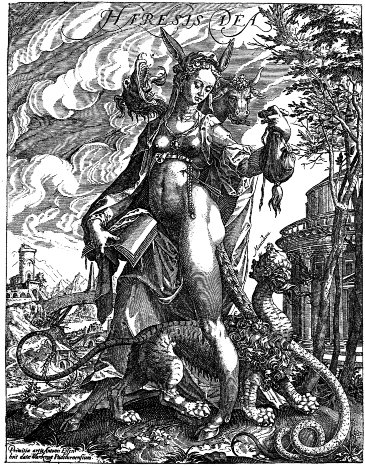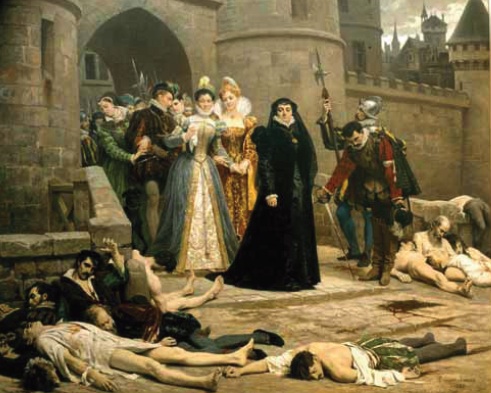An account of religious heresy. Hardly. No one can match Gottfried Arnold’s Impartial History of the Church and the Heretics. The Lutheran priest published the two volume tome in 1699 to almost universal disdain from within the Church and their supporters, and there were fewer heresies then than now. The uproar was not easily calmed and from the amplitude and magnitude of scorn heaped on Gottfried it can be deduced, that on the whole he took the side of the heretics. To devise one’s own religion. That is, in fact, what heresy is in terms of its literal meaning: private choice, the opposite of orthodoxy which is not chosen but imposed and accepted. The pure heretics are those who never created an established church or an orthodoxy and whose members came to it by personal choice. …

—According to Vatican II’s Unitatis Redintegratio, Catholics may not presume most non-Catholic Christians to be morally responsible for rejecting, or at least doubting, distinctively Catholic doctrines. But when we use the word ‘heretic’ for any particular individual or group, that’s exactly what we’re heard as doing even when we don’t intend to do it. And so the word ‘heretic’ should be used very sparingly if at all for non-Catholics.
But of course there is such a thing as heresy, and it’s not an endangered species. … The Church does not need to rule, juridically, that they are heretics in order that we may know them as such; such a ruling is merely useful for ensuring that use of the H-word be taken as more than just an expression of private opinion. A bigger problem, though, is that countless Catholics, though not heretics in the formal sense, are material heretics. I.e., some of their beliefs are objectively incompatible with de fide teaching; but since they don’t know that, they can’t be held subjectively accountable for heresy. Here use of the H-word is even more inadvisable; for it generates emotional responses that make it all the harder for the real truth to be heard.
Nonetheless and etymologically, the H-word is quite apt for describing the attitude of “cafeteria Catholicism.” It comes from the Greek hairesis, meaning “choice.” Heresy is choosing to believe this but not that tenet of what is, objectively, the faith-once-delivered; or, in the consumerist American version, it is to choose a little of this, a little of that, and none of the rest.—Read More:http://mliccione.blogspot.ca/2007/02/from-hell-to-heresy.html
Lets take the puritans first. Undoubtedly the early Church was puritanical. So were its Old Testament models. The prophets, from Elijah to John the Baptist had been puritans, denouncing the gay polytheism, the local cults, the jolly beanfests of the Syrian tribes that surrounded and seduced the grim people of god. All through the first three centuries after Christ, the church had kept itself pure from similar contamination. The early Christian writers had denounced such unedifying pagan habits as the burning of incense, the “impious and detestable” practice of sprinkling holy water, the absurd use of candles and votive pictures, the “profane, damnable, impious” cult of images, etc., etc.

—Sometimes good, conservative, orthodox (Catholics who liberally accept all the teachings of the Church, thus they are really “liberal”) do have a tendency to call others heretics. So just what qualifies one to be a heretic?
I think this definition from the Catholic Encyclopedia is pretty good. What do you think?
Both matter and form of heresy admit of degrees which find expression in the following technical formula of theology and canon law. Pertinacious adhesion to a doctrine contradictory to a point of faith clearly defined by the Church is heresy pure and simple, heresy in the first degree. But if the doctrine in question has not been expressly “defined” or is not clearly proposed as an article of faith in the ordinary, authorized teaching of the Church, an opinion opposed to it is styled sententia haeresi proxima, that is, an opinion approaching heresy. Next, a doctrinal proposition, without directly contradicting a received dogma, may yet involve logical consequences at variance with revealed truth. Such a proposition is not heretical, it is a propositio theologice erronea, that is, erroneous in theology. …—Read More:http://southernorderspage.blogspot.ca/2011/04/who-of-you-is-heretic-get-thee-to-stake.html
Such practices, the Christians thought, were exactly the kinds of things which the prophets had denounced and which Christ had ordered them to ignore, saying that mercy was better than sacrifice, evangelical poverty and mutual charity better than sophisticated profusion or pharisaical ritual. So the early Christians kept themselves apart from society, trying to live like the first disciples, without compromise, in “apostolic poverty” and “primitive communism,” a self-contained, puritan “out-group” in the secular pagan world.
Unfortunately the virtues of a sect can rarely be preserved in an established church, and when Constantine made Christianity the official religion of the Empire, the bishops soon yielded to the temptations, or the necessities of power. Little by little the Christian clergy took over some of the methods of the pagan priests whom they had replaced. With the pagan temples they adopted the pagan sacrifices. Pagan gods became Christian saints. Apostolic poverty was forgotten. And the puritan virtues were left, as the unvalued relics of an outworn chrysalis stage, to the heretics who refused to move with the times.
ADDENDUM:
(see link at end)…During the crusade on Christian heretics (Albigensian Crusade or Cathar Crusade) in the early 13th century, Pope Innocent III led the nobility of northern France.
When they reached the city of Beziers, in the south of France near the Mediterranean coast, they surrounded it.
A question among the crusaders arised: how to distinguish true Christians from heretics who follow the so-called Cathar learning?
Cistercian monk Arn
Amalric and French nobleman Simon IV de Montfort suggested unusual solution to the pope:“Kill them all. For the Lord knows them that are His (Caedite eos. Novit enim Dominus qui sunt eius ).”
Unfortunately, the pope and crusaders did as suggested. The entire population of twenty thousand Cathars and Catholics that lived in Beziers were slaughtered. Read More:http://zumaworld.blogspot.ca/2011/07/lord-knows-arnaud-amalric-and-simon-iv.html

—France: “Suffering” Heretics
By the end of 1576 L’Hospital’s worst nightmares had come true. Force had utterly failed to reunite the people of France in concord. Not even five civil wars in 15 years and the St. Bartholomew’s Day massacre (August 24-25, 1572), which produced mortality on the scale of the attack on New York in September 2001, had done the trick. While no one knew that three more wars, taking up 15 of the next 22 years, were still to be waged, it was clear that the guerres de religion were far from over. Consequently, even arch-Catholics were starting to come around to L’Hospital’s way of thinking.
At a meeting of the Estates-General of France in 1577, each of the three Estates (the nobility, the clergy, and the commoners) resolved in favor of uniformity of religion. But the Duke de Montpensier, one of the favorite counselors of King Henry III and known for his Catholic zeal, shocked the deputies with a speech arguing for limited toleration.—Read More:http://www.libertymagazine.org/index.php?id=1758





 COMMENTS
COMMENTS